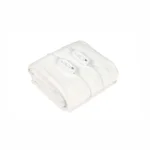Electric Blankets
An electric blanket is two pieces of fabric sewn together with heat coils running in-between, they are installed with shut off devices, temperature controls and sometimes timers. They are used as an alternative and cheaper way to stay warm and comfortable, especially popular in colder months of the year.
The first undercover electric blankets were invented in 1912 by Samuel Irwin Russel; the overcover electric blankets were not invented until the 1930s. Regardless, electric blankets did not begin to gain popularity until the conclusion of World War II, with particular popularity being found in the United States. Since then, electric blankets have improved their energy efficiency, introduced safety features, added timers and become more affordable, making them more accessible to everyday households.
How long do electric blankets last?
Electric blankets have a manufacturer’s average lifespan of 10 years, and should be tested by a qualified electrician every 2 years. The lifespan of an electric blanket may be impacted by improper use, so ensure you:
- Do not fold electric blankets
- Store them flat or rolled up
- Do not leave them switched on overnight
- Do not use a hot water bottle or drink liquids when you have the blanket fitted in case of a spillage
- Keep pets off
Can you wash electric blankets?
Whether an electric blanket can be washed differs from each product, the best way to find out is to check the technical specifications or check the care label to say it’s safe to do so. Regardless, most modern electric blankets can be washed, no different than washing a pillow or weighted blanket. Before washing, ensure you remove the control cord as this should never be submerged in water, after that, simply follow the manufacturer’s washing instructions and your electric blanket will be clean and fresh, ready for use again.
Should you sleep with an electric blanket?
Despite safety features to automatically power off at a certain temperature, electric blankets have the capacity to be a fire hazard, even if this is extremely unlikely it is best not to risk. Furthermore, too much heat from the blanket can actually interrupt your sleep, and can make you feel overheated or dehydrated. Therefore, it’s best not to sleep with an electric blanket on and should be turned off before sleeping.
Do electric blankets damage mattresses?
Electric blankets should not damage conventional mattresses, with no risk of burns to the mattress due to modern electric blankets having safety features designed to power off when reaching too high of a temperature. However, some mattresses are unsuitable to combine with an electric blanket. Water beds should never be used in conjunction with an electric blanket for obvious reasons and whilst electric blankets do not damage memory foam mattresses, it may change and warp the shape of the memory foam due to the electric blanket heat created by the electric blanket. Ideally, you should check with the mattress manufacturer and find out whether they recommend against the use of an electric blanket with their mattress.
Is a heated blanket cheaper than heating?
Heating with an electric blanket is much more cost-effective than heating your entire household. Depending on the wattage and heat setting chosen, you can save an exponential amount of money choosing an electric blanket over central heating for your household. Based on current kWh per hour pricing, on average, it would cost you around 3p to run an electric blanket for an hour







